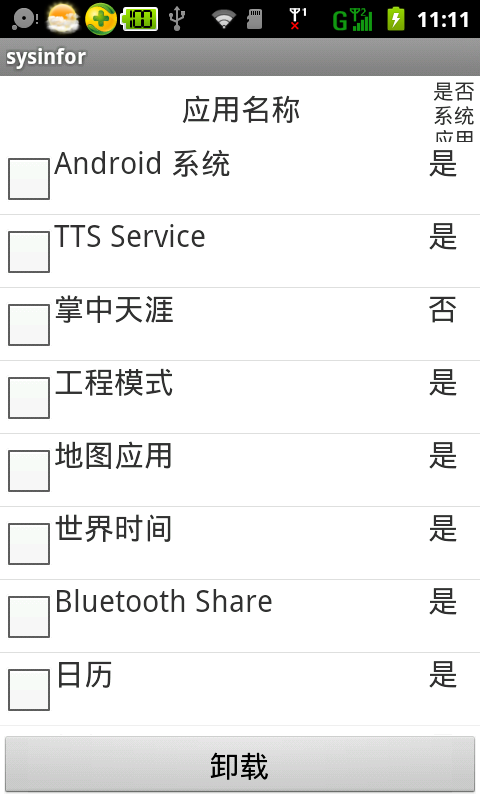Android中经常用到列表,ListActivity是实现列表的一种好方法。
使用ListActivity的方法,首先定义布局文件:
<?xml version="1.0" encoding="utf-8"?>
<LinearLayout xmlns:android="http://schemas.android.com/apk/res/android"
android:layout_width="match_parent"
android:layout_height="match_parent"
android:orientation="vertical" >
<LinearLayout
android:layout_width="fill_parent"
android:layout_height="match_parent"
android:layout_weight="5" >
<TextView
android:id="@+id/textView1"
style="@style/my_style"
android:layout_width="match_parent"
android:layout_height="fill_parent"
android:layout_weight="4" />
<TextView
android:id="@+id/textView2"
style="@style/my_style"
android:layout_width="match_parent"
android:layout_height="fill_parent"
android:layout_gravity="center_vertical|center_horizontal"
android:layout_weight="1"
android:gravity="center_vertical|center_horizontal"
android:text="应用名称" />
<TextView
android:id="@+id/textView3"
android:layout_width="match_parent"
android:layout_height="fill_parent"
android:layout_weight="4"
android:gravity="center_vertical|center_horizontal"
android:text="是否系统应用" />
</LinearLayout>
<ListView
android:id="@id/android:list"
android:layout_width="fill_parent"
android:layout_height="match_parent"
android:layout_weight="1" >
</ListView>
<Button
android:id="@+id/btn_apk"
style="@style/my_style"
android:layout_width="fill_parent"
android:layout_height="match_parent"
android:layout_weight="5"
android:text="卸载" />
</LinearLayout>
其中,最关键的就是ListView控件。
然后,再用一个布局文件定义列表中的每一行:
<?xml version="1.0" encoding="utf-8"?>
<LinearLayout xmlns:android="http://schemas.android.com/apk/res/android"
android:layout_width="match_parent"
android:layout_height="match_parent"
android:orientation="horizontal" >
<CheckBox
android:id="@+id/chk_apk"
android:layout_width="match_parent"
android:layout_height="fill_parent"
android:layout_weight="4" />
<TextView
android:id="@+id/txt_item_name"
style="@style/my_style"
android:layout_width="match_parent"
android:layout_height="fill_parent"
android:layout_weight="1"
android:text="TextView" />
<TextView
android:id="@+id/txt_item_flag"
style="@style/my_style"
android:layout_width="match_parent"
android:layout_height="fill_parent"
android:layout_weight="4"
android:text="TextView" />
</LinearLayout>
最后,在类文件中使用SimpleAdapter类把列表显示出来。
package com.hzhi.sysinfor;
import java.util.ArrayList;
import java.util.HashMap;
import java.util.List;
import java.util.Map;
import android.app.ListActivity;
import android.content.Context;
import android.content.pm.PackageInfo;
import android.content.pm.PackageItemInfo;
import android.content.pm.PackageManager;
import android.os.Bundle;
import android.widget.SimpleAdapter;
public class apk extends ListActivity{
Context mCtx;
SimpleAdapter my_adaptor;
protected void onCreate(Bundle savedInstanceState){
super.onCreate(savedInstanceState);
setContentView(R.layout.activity_list_apk);
my_adaptor = new SimpleAdapter(this,
get_data(),
R.layout.list_item_apk,
new String[]{"name", "flag"},
new int[]{R.id.txt_item_name, R.id.txt_item_flag});
setListAdapter(my_adaptor);
mCtx = MainActivity.mContext;
}
}
其中get_data()返回一个List<Map<String,String>>,R.layout.activity_list_apk是定义整个列表的布局文件,R.layout.list_item_apk是定义列表中每一行的布局文件。
运行的结果:
